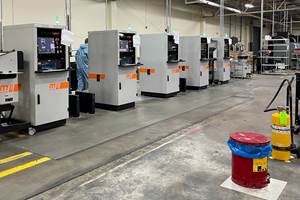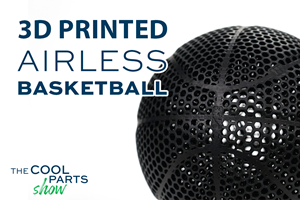Adopting a Growth Mindset for AM
Don’t let your fear of failure stop you from learning.
Efforts like the “Additive Manufacturing: Why the Failure?” (#AMWTF) series on LinkedIn are helping destigmatize build failures and foster a growth mindset for the AM community.
With all the talk of build failures, flaws and defects, it is easy to see why people can get scared of using additive manufacturing (AM), and metal AM in particular. Keyholing, lack of fusion, gas porosity, delamination, recoater crashes… the list goes on and on, and we academics only tend to make it worse. Why? Because these failures help us justify the research and experimental work needed to understand the problem and mitigate the associated risk. The outcome and intentions are good, but I am starting to worry that we have only exacerbated people’s fears, not cultivated the growth mindset that is needed to overcome them.
I am just as guilty of this as anyone else. In fact, I gave an entire day-long workshop to a group of senior engineers who wanted to know everything that could go wrong with metal AM when used on their medical implants. Their goal was to understand what questions they needed to ask their engineering staff to make sure that things did not fail, and it was one of the most fun workshops that I have ever done in a company. Unfortunately, by the end of the workshops, even I was asking myself why the heck would I ever want to use AM given everything I had just learned? Needless to say, I have never offered that particular workshop again, and I make sure to provide at least one solution to mitigate each risk whenever failures are discussed.
At the same time, one of the best ways to learn is through failure — something that many people fear or don’t want to admit happened to them. It is referred to as “productive failure,” but as an academic, I have a hard time publishing a paper on anything that fails. Journals (and peer reviewers, in particular) only want to know what works and what improvements have been made, not all of the false starts or mistakes that you had to overcome along the way.
This is what motivated me to launch Additive Manufacturing: Why The Failure? (#AMTWF) with Pete Zelinski – the editor-in-chief of Additive Manufacturing and Modern Machine Shop – this past spring. Each month, we share one of the build failures from CIMP-3D, the metal AM center that I co-direct at Penn State. As each failure is revealed, anyone can comment on why they thought the build failed or pose questions to help them ascertain why the failure occurred. I then respond to each comment, revealing additional information and, occasionally, another image of the failure. Eventually, the discussion tapers off, and Pete and I videotape an explanation of why the failure occurred, incorporating comments posted on LinkedIn into our discussion. We also make sure to discuss how this failure could be avoided or mitigated in future builds.
Our #AMWTF series seems to have struck a chord within the AM community (or at least those of us online) as the response to each posting surpassed our expectations. We quickly picked up a steady online following from both industry and academia, and new participants would join as we posted each new failure. The interactive nature of the “Comment-Reply-Comment” kept everyone engaged, and a dialogue emerged online that began to destigmatize AM build failures, alleviating some the shame or disgrace that can be associated with a failure.
Granted, no one wants to fail, but AM is still so new that you will invariably fail along the way as you push the limits of your AM knowledge or try something new with an AM process. As an AM engineer and designer, I am constantly asking how do we make this wall thinner? Do we really need support structures on this overhang? Is this bridging distance too much? Or even more unorthodox questions about intentional porosity or leaving trapped powder inside a structure.
The list of questions goes on and on and on, and you never know what idea or innovation a crazy question will trigger — or a build failure will reveal. If individuals are afraid to face their fears and come at AM with a fixed mindset, then you can imagine how difficult it will be to fully embrace AM and enjoy its benefits. Unfortunately, the situation can be even more daunting if you work in an organization where “failure is not an option” as the associated culture and risk tolerance will invariably stymy AM adoption from the start.
This is where a growth mindset is essential for AM right now. Individuals need to be willing to embrace new challenges, take risks and persevere in the face of failure — without the fear of humiliation. Granted, we do not want AM parts that fail in use, but organizations need to create psychologically safe environments for people to be creative with and explore AM so that they get it right. This is easier said than done, and not something that changes overnight. It takes time, commitment and resources to overcome not only the technical challenges associated with AM but also the psychological barriers individuals and organizations will face when trying to displace well-established manufacturing methods with AM.
AM is hard, but don’t let the fear of failure hold you back. More and more companies are figuring it out, and you have to be open and willing to take risks and face your fears to make it happen. Otherwise, you will find yourself (and your company) left behind with a fixed mindset that failed to achieve the benefits that others are finding.
Related Content
Additive Manufacturing Production at Scale Reveals the Technology's Next Challenges: AM Radio #28
Seemingly small issues in 3D printing are becoming larger problems that need solutions as manufacturers advance into ongoing production and higher quantities with AM. Stephanie Hendrixson and Peter Zelinski discuss 6 of these challenges on AM Radio.
Read MoreVelo3D Founder on the 3 Biggest Challenges of 3D Printing Metal Parts
Velo3D CEO and founder Benny Buller offers this perspective on cost, qualification and ease of development as they apply to the progress of AM adoption in the future.
Read More3D Printed Cutting Tool for Large Transmission Part: The Cool Parts Show Bonus
A boring tool that was once 30 kg challenged the performance of the machining center using it. The replacement tool is 11.5 kg, and more efficient as well, thanks to generative design.
Read MoreAirless Basketball Shows Promise of 3D Printed Lattices: The Cool Parts Show Bonus
Successfully matching the performance of a standard basketball demonstrates the control possible over the mechanical properties of digital materials.
Read MoreRead Next
4 Ways the Education and Training Challenge Is Different for Additive Manufacturing
The advance of additive manufacturing means we need more professionals educated in AM technology.
Read More3D Printing Brings Sustainability, Accessibility to Glass Manufacturing
Australian startup Maple Glass Printing has developed a process for extruding glass into artwork, lab implements and architectural elements. Along the way, the company has also found more efficient ways of recycling this material.
Read MoreHybrid Additive Manufacturing Machine Tools Continue to Make Gains (Includes Video)
The hybrid machine tool is an idea that continues to advance. Two important developments of recent years expand the possibilities for this platform.
Read More






















